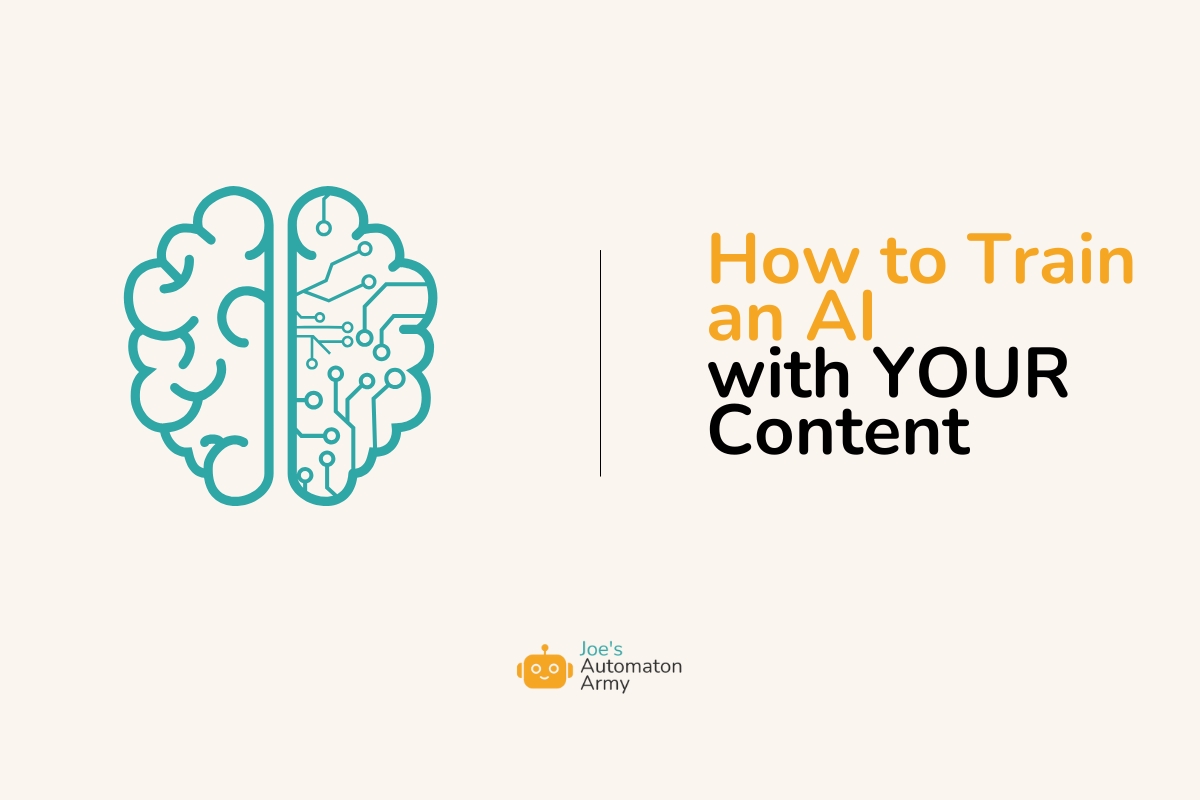Did you know you can train an AI on your own content? For example:
-
- Your book
- Your blog
- Your customer data
- Your budget
- Your favorite Shakespeare play
You can! In fact, you could train an ai and have it up and running in one hour or less, and today, I’m going to show you exactly how to do it.

Watch it: How to Train an AI on YOUR Content
Prefer to watch? Check out the Youtube walkthrough here:
WHY Train an AI on Your Content
Training and AI used to be kind of complicated. It used to take hours, some knowledge in coding, access to some kind of server where you could connect with an API.
It was a bit too hard for the average person. But now it’s very much not complicated. In fact, it takes about a minute.
Anyone can do this, and that means that you could train an AI on your book or your blog or your website, so that answers questions based on your content.
You could train an AI based on your customer data. So that when they email you or message you about their latest transaction, you could have that info ready for them. You could train your AI on your budget and then ask it whether you can buy that cool new robot vacuum maybe you’ve been wanting. You could even train an AI to talk like Hamlet.
By the way, this is what we’re doing at WriteCoach.ai. I’ve trained a model in our content from The Write Practice. We’ve published over three million words at The Write Practice. I’ve trained our AI in not all of those words, but the most important ones, and now we have an AI that’s trained in our process and is helping members of our community. You could do that as well!
And today I’m gonna show you exactly how easy it is to do it.
The 2 Ways to Train an AI (And Which is the Best)
There’s two ways to train an ai, okay?
The first way is through fine tuning and basically you have A-J-S-O-L file which is a bunch of example conversations. That you write up and you want the AI to study those conversations and learn how you have those kinds of conversations. Fine tuning is really good for getting the tone right of a conversation.
It’s really good at making it sound like you and your voice. It is actually not very good at learning data at learning customer information, for example, or information about like, concepts in your book?
Unfortunately it’s not very good at that, so I spent a long time trying to figure out how to do fine tuning and it’s great. You should do it. We’re not gonna talk about that today. There’s another training method that’s better for this kind of content for the AI to learn your content, and that’s called rag retrieval Augmented Generation. I think I got that right. Doesn’t really matter. It’s rag .
And basically how RAG works is that the user asks a question, they say, tell me a story, or something like that. Normally the chat would just like search through all its data set and find an answer to that person’s. Question tells ’em a story. Okay? Now what the rag does is
it goes and grabs a bunch of content that you uploaded to it and adds it to the prompt and says, so you tell a story and it goes and searches through all of the data that you uploaded. Finds the most relevant bits, okay. Adds it to the prompt, and then the chat just says, oh, here’s all this helpful training data.
I’m just gonna make it work to answer this question. Okay?
So just as fine tuning is better for tone and voice and making sure it sounds like you rag is really good at getting data for your person.
They also make it a lot easier for us, which is really nice.
How to Train an AI in Less Than an Hour: 3 Steps
Ready to create your own custom-trained AI assistant?
Step 1: Go Open AI’s API Area (platform.openai.com)
First, you need to create an API account through Open AI.
Note: we’re gonna work just with chat GPT because they make this the easiest right now. You can also do this with Claude and other AI models, but it’s not nearly as easy.
To create your account, go to openai.com scroll all the way down or go directly to platform.openai.com, create an account there, and then go to the Dashboard.
You might have to add a payment method. It’s really simple and should only take a few minutes. They make it really easy. Once you get here, okay, I want you to just take a look at some things. Now, the most important thing we’re gonna talk today about is assistance, but I also want you to just look at this fine tuning thing.
Step 2: Create an Assistant
Here’s how you can use RAG to train your AI in just a minute:
- Go to “Assistants”
- Click “Create an assistant”
- Name it whatever you want, e.g. “Hamlet”
- (Optional) Give it some instructions
- Select the Model, must be GPT-4o and up
- Turn on “File Search” and upload a file
Your done! You can now test your trained assistant in the Playground!
Here’s what the AI model is doing: it’s taking your file and breaking it into chunks, usually 200 to 400 words or so, and for each chunk it’s gonna give it a keyword, some kind of summary of what that chunk is about. Then, just like a search engine, it’s going to look through your content when it’s answering a question and add it to the message, using the message to respond to the user’s message.
How to Actually USE Your Assistant With Zapier
Now, this is really nice for creating your own AI trained on your data, but how do you serve that to others? How do you allow other people to use this?
One of the easiest ways is through Zapier.

As you know, we’re huge fans of Zapier at Automaton Army, and once you’ve created your assistant, you can easily hook it up to any Zap you want.
For example, let’s say someone fills out a form on your website, then you get the message from your user, have your custom trained assistant answer the question, and then send it to your user however you want, say through an email.
Now you have your assistant instantly available in your own workflow.
Tips and Next Steps to Train Your AI
Now there are some drawbacks with this. OpenAIs embedding system is going to do an okay but not amazing job at chunking your content in ways that make sense. So instead of having it chunk your content, you might choose to create your own RAG, your own breakdown of your content so that it’s well structured.
One of the problems that I was running into with this is that it pulls sometimes the wrong parts of my book into the chat and answers questions with the wrong content. You could instead use more specific training data, or create your own structured content through a JSON file instead of a txt file.
If you want to go even further, you could create your own RAG system on your website to use JUST the content you want, which is what we’ve done with writecoach.ai. This process is surprisingly easy, but it does take some coding.
For most people, though, uploading with File Search will do a great job.
How Are YOU Going to Train Your AI?
So that’s how you train an ai. It’s pretty easy, right? You could do this in the next 15 minutes, and have an AI answering questions based on your content, on your data, your own personal assistant. How cool would that be? And then if you want to use Zappier to connect it to the tools that you’re already using, you can do that as well.
So let me know, are you gonna do this? What AI are you going to create? Let me know in the comments.
